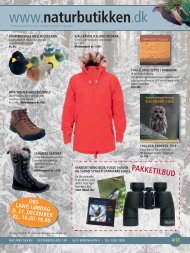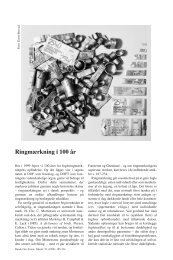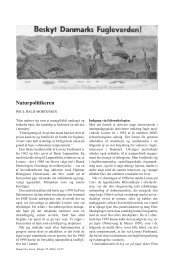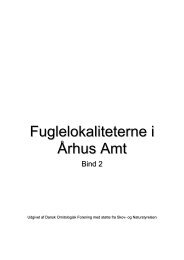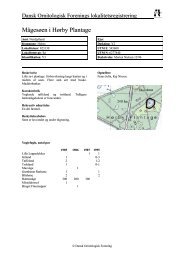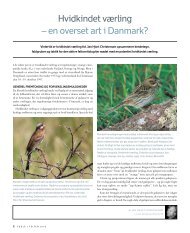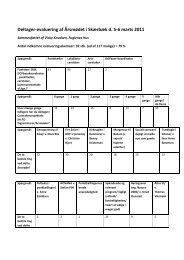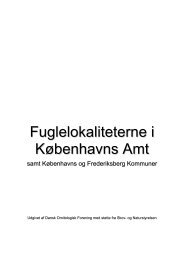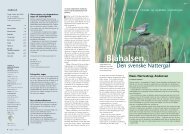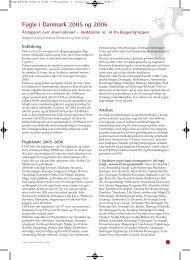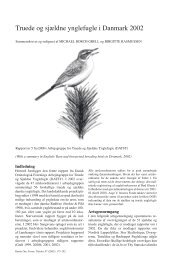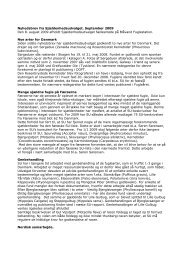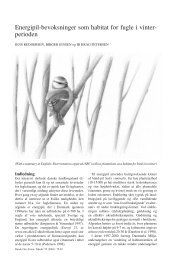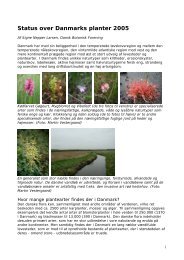Ynglefugle i Vejlerne - Dansk Ornitologisk Forening
Ynglefugle i Vejlerne - Dansk Ornitologisk Forening
Ynglefugle i Vejlerne - Dansk Ornitologisk Forening
You also want an ePaper? Increase the reach of your titles
YUMPU automatically turns print PDFs into web optimized ePapers that Google loves.
ut this positive development was followed by declines<br />
that could be attributed to drainage and destruction of<br />
wetlands, persecution of migrating Marsh Harriers, and<br />
the introduction of pollutants such as DDT and PCB,<br />
which had very adverse effects on productivity of raptors<br />
and other top-predators during the 1950s and 1960s.<br />
In 1967 Marsh Harriers were protected from hunting<br />
year-round in Denmark, and the worst environmental<br />
pollutants became subject to bans over a wider international<br />
scale, including much of the Danish Marsh Harriers<br />
y-way, and especially the latter is considered responsible<br />
for the major increase in Marsh Harrier numbers<br />
seen over most of Europe since then. The increase<br />
in <strong>Vejlerne</strong> was somewhat delayed compared to other<br />
parts of Denmark, suggesting local factors have been involved<br />
as well. The population in the reedbeds of Bygholm<br />
Nord 1978-2003 is strongly and positively correlated<br />
to the water level in March-May (strongest correlation<br />
in March, when birds arrive and settle in territories;<br />
Fig. 40). Signicant correlations between the population<br />
and precipitation in April and temperatures in March are<br />
also evident, but weaker than those seen for the water<br />
level inuence on numbers.<br />
A negative correlation exists between the breeding<br />
population and reed cutting intensity. The best correlation<br />
is found with winter reed cutting 1½ years prior to<br />
the breeding season, but correlations with reed cutting<br />
immediately before, 2½ and 3½ years before breeding<br />
has also been found.<br />
The rst Marsh Harriers arrive between February 12<br />
and March 31 (average date March 12). The period with<br />
records of Marsh Harriers in <strong>Vejlerne</strong> is given in Fig. 41,<br />
and a tendency to gradually earlier arrival as well as later<br />
departure over the study period from 1978 to 2003 is<br />
recognized. The arrival date is determined by temperature,<br />
the warmer the earlier arrival. On average <strong>Vejlerne</strong><br />
has hosted Marsh Harriers 238 days per year, and the<br />
length of the staging period is positively correlated with<br />
the breeding population size. The breeding Marsh Harrier<br />
population of <strong>Vejlerne</strong> is, despite its small size, composed<br />
of birds with the longest staging period on their<br />
breeding site in Denmark. The first fledged juvenile<br />
Marsh Harriers has been seen between June 28 and July<br />
17, on average July 6, and the birds of <strong>Vejlerne</strong> breed<br />
earlier than in other investigated Danish populations.<br />
Until the 1960s <strong>Vejlerne</strong> held more than 10% of the<br />
Danish population. Later population growth was higher<br />
outside than within <strong>Vejlerne</strong>, and in the mid-1990s<br />
when the Danish population was estimated at 650 pairs,<br />
<strong>Vejlerne</strong> only had 2-5% of these. With the local increase<br />
in the population at <strong>Vejlerne</strong> after 2000, the proportion<br />
of the Danish total might have increased as well, but<br />
new national surveys that could document this is not<br />
available.<br />
Montagu's Harrier was previously a regular but rare<br />
breeder in and adjacent to <strong>Vejlerne</strong>. The species disappeared<br />
from the area in the late 1960s, apart from a single<br />
breeding attempt in 1997.<br />
Breeding birds in <strong>Vejlerne</strong> 221<br />
Quail was rst recorded in the area around 1970. Since<br />
1983 singing males have been recorded almost an nually<br />
in the vicinity of <strong>Vejlerne</strong>. Large inter-annual uctuations<br />
in numbers of birds involved is seen in <strong>Vejlerne</strong><br />
(Table 27), and is parallel to similar variations in numbers<br />
in other parts of Denmark. After 2000 numbers<br />
have remained generally high. Some years <strong>Vejlerne</strong> host<br />
10-20% of all Quails recorded in Denmark.<br />
Water Rails have been noticed for their nocturnal "choruses"<br />
in <strong>Vejlerne</strong> since the 1930s, but only after 1978 attempts<br />
have been made to actually quantify the population<br />
size. The records compiled by the Field Observatory<br />
staff in terms of mapped territories must, however, only<br />
be considered as an index of population size, because<br />
some parts of the reed beds are so large that the species<br />
is practically impossible to count. The data available<br />
nevertheless demonstrate a major increase in the population<br />
size from 1978 to 2003 (Table 28, Fig. 42). Most of<br />
the mapped population has been found in the three large<br />
continuous reedbeds, i.e. Bygholm Nord, Selbjerg Vejle<br />
and Tømmerby Fjord (with respectively 32%, 29% and<br />
18% of the population).<br />
The water level in the reeds of all three areas has major<br />
importance for the population size which is positively<br />
correlated with water levels in March-May (Table<br />
29, Figs. 43-45). Hence most Water Rails are found in<br />
springs with high water levels. The rails apparently are<br />
also negatively inuenced by reed cutting as I found a<br />
signicant and negative correlation between the population<br />
size and reed cutting intensity in the three preceding<br />
winters. The population also seems to be inuenced by<br />
the winter temperatures prior to the breeding season, a<br />
somehow surprising result, because the Rails are thought<br />
to winter in milder regions of Europe (on either side of<br />
the British Channel and in France).<br />
It is likely that the true population of Water Rails in<br />
<strong>Vejlerne</strong> is more than 1000 pairs. The size of the Danish<br />
population is unknown, but <strong>Vejlerne</strong> is without any<br />
doubt the single most important site for the species in<br />
Denmark.<br />
Spotted Crakes have been noticed in variable numbers<br />
in <strong>Vejlerne</strong> since the 1930s, but systematic surveys<br />
were not initiated before 1978 (Table 31, Fig. 47).<br />
The observed uctuations in numbers are more dramatic<br />
than that of any other breeding bird in <strong>Vejlerne</strong>. The<br />
development in <strong>Vejlerne</strong> generally has been parallel to<br />
that observed in the rest of the country, partly because<br />
<strong>Vejlerne</strong> by far has the largest population, and this represents<br />
40-60% of all singing Spotted Crakes recorded<br />
in Denmark.<br />
Most crakes have been mapped in swampy marshes<br />
with tussocks in the transition zone from meadows to<br />
reedbeds in Østlige Vejler. It is unknown how big a proportion<br />
of the recorded birds have been true breeders.<br />
The rst singing bird has been recorded between April 2<br />
and May 26, on average April 17.



